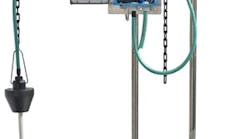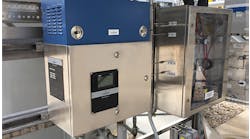Sample Preparation System
Figure 2. Such units must contain filter media and sometimes include a sample delivery pump.
Installation of the sample system demands care. You must position the sample system filter in the process to ensure extraction of a representative sample. In addition, you must choose a filter porosity appropriate for the application. The filter porosity should match that used for any comparative lab tests. The filter should be readily accessible and easy to clean on a routine basis.Ideally, a system should offer automatic cleaning with air backwash or even chemical cleaning. Chemical cleaning can be critical in an influent installation where greases or oils can be present, along with high biological activity that can lead to filter or sample line plugging.For freezing weather environments, install tracing or another appropriate heating option on the sample system tubing.
Operational ImperativesAchieving the most economic and effective ongoing performance of a field-based analyzer requires paying adequate attention to three key factors: consumables, components and control system integration.
Consumables. Operating costs of colorimetric analyzers rise and fall with reagent consumption. The more reagent required for each analysis, the higher the operating costs will be. The key to keeping costs low is long reagent life and small consumption with each analysis.Look for reagents that are easy to prepare and have a long shelf life prior to preparation and after installation in the analyzer. A longer shelf life allows you to purchase the materials well in advance, so product is on hand when reagent replacement is necessary.Higher consumption rates mean reagents will need changing out more often, increasing overall maintenance costs. Systems that track reagent usage and indicate when it’s time to replace reagents assist in efficient analyzer maintenance. Some systems offer internal reagent cooling systems to help extend the life of reagents, reducing replacement frequency. Consider this approach to increase reagent lifetime.Besides reagent consumption, each internal cleaning and calibration cycle consumes chemicals. In some analyzers, the rate of cleaner consumption will vary based on water hardness, which can add to the cost of operation.
Components. Any photometric/colorimetric analyzer will require routine maintenance that involves pump and tubing replacement, along with upkeep of valves and motors that may exist. Overall cost of ownership highly depends on the number of wear parts, their frequency of replacement, cost and impact on analyzer downtime. So, consider the inner workings of the analyzer and the wear components’ lifetimes stated by the manufacturer. Some analyzer designs require extensive part replacements that rely on an array of tools. Newer designs significantly reduce the number of parts requiring service, virtually eliminating the need for tools and dramatically decreasing the time required to perform routine maintenance.Historically, peristaltic pumps handled reagent and sample dosing. New analyzers now rely on dosing syringe pumps that are more precise, consume less liquid, need replacement less frequently and are easy to change out.
Control system integration. Today’s photometric/colorimetric analyzers offer a range of output options from traditional 4-20-mA analog to fieldbus digital communications such as Profibus, Modbus or EtherNet/IP. Additionally, some systems provide the ability to integrate other sensor measurements within the analyzer, expanding its functionality and reducing capital costs for additional measurement values.
Take To The FieldDon’t relegate colorimetric/photometric analysis to the laboratory. Getting accurate and reliable measurement of various parameters in situ has become a more attractive option. The advent of newer analyzer designs dramatically reduces reagent consumption and eases maintenance. These newer systems, working in conjunction with improved sample preparation systems, can provide laboratory-quality results at a much lower cost of ownership than a lab-based system.However, perhaps the biggest advantage of field-based analyzers is their generation of nearly real time data. This allows for tighter control of a process thanks to a higher frequency of accurate actual process data.
STEVEN SMITH is a Lafayette, Colo.-based senior product marketing manager – analytical for Endress+Hauser USA. Email him at [email protected].

